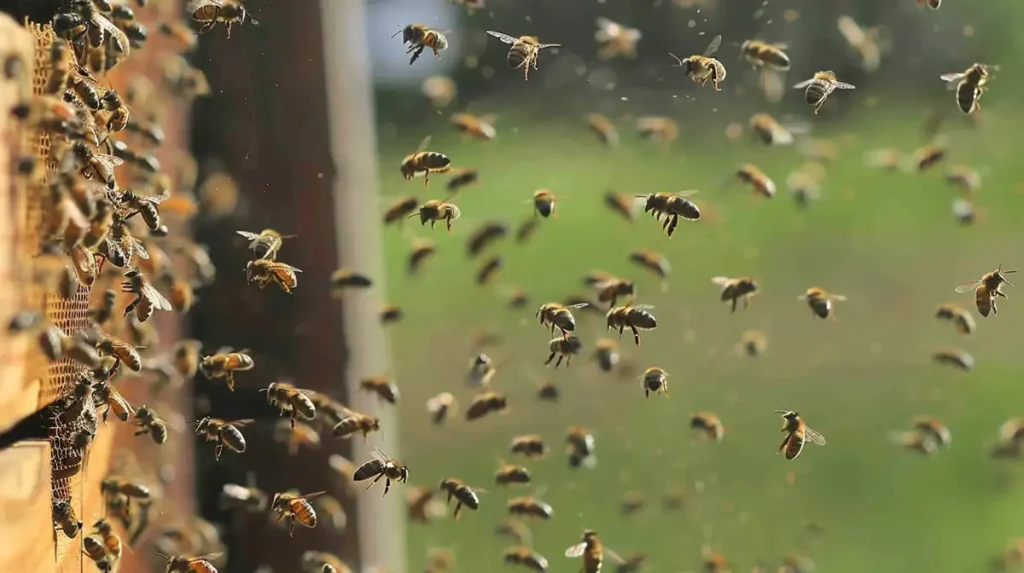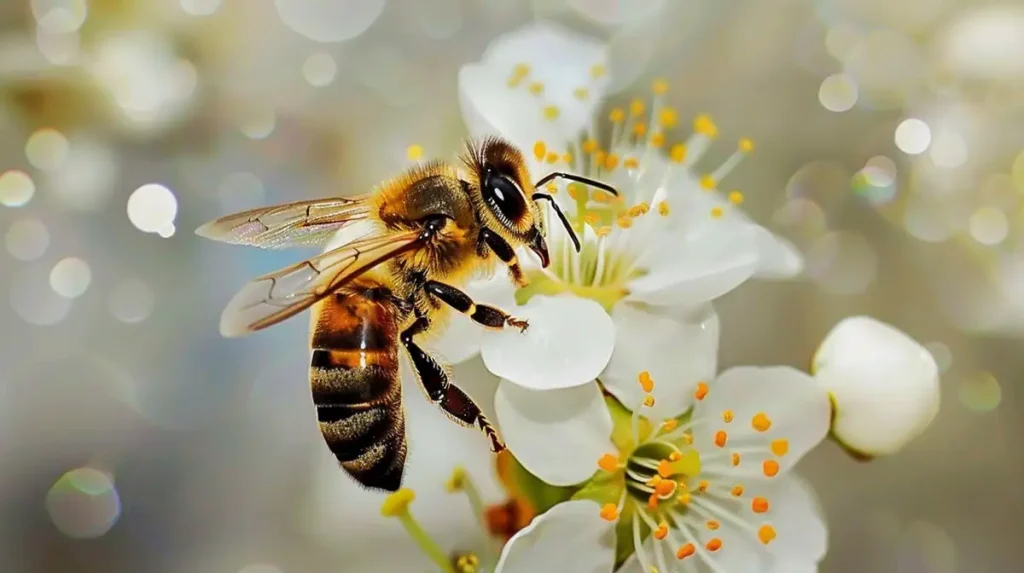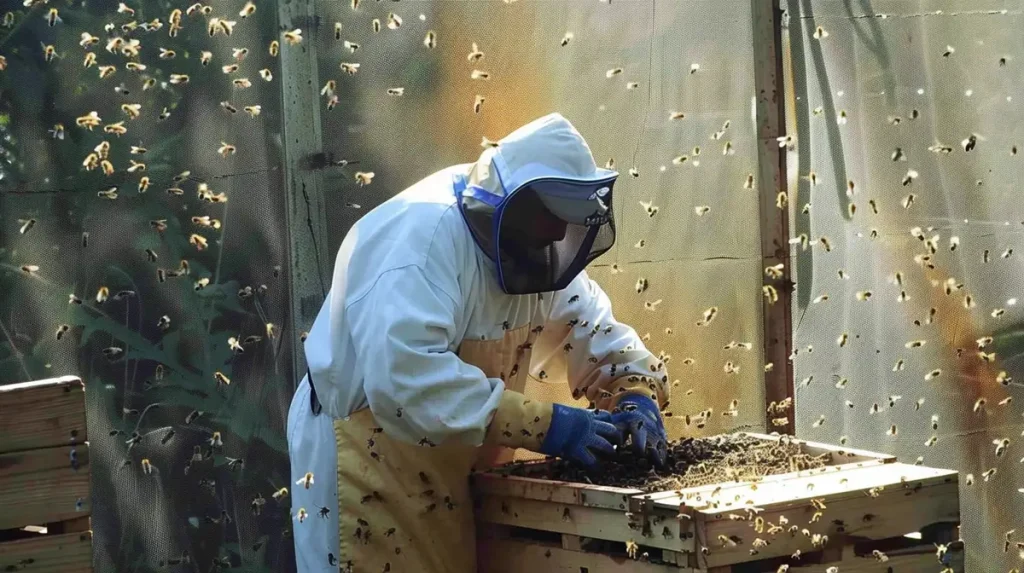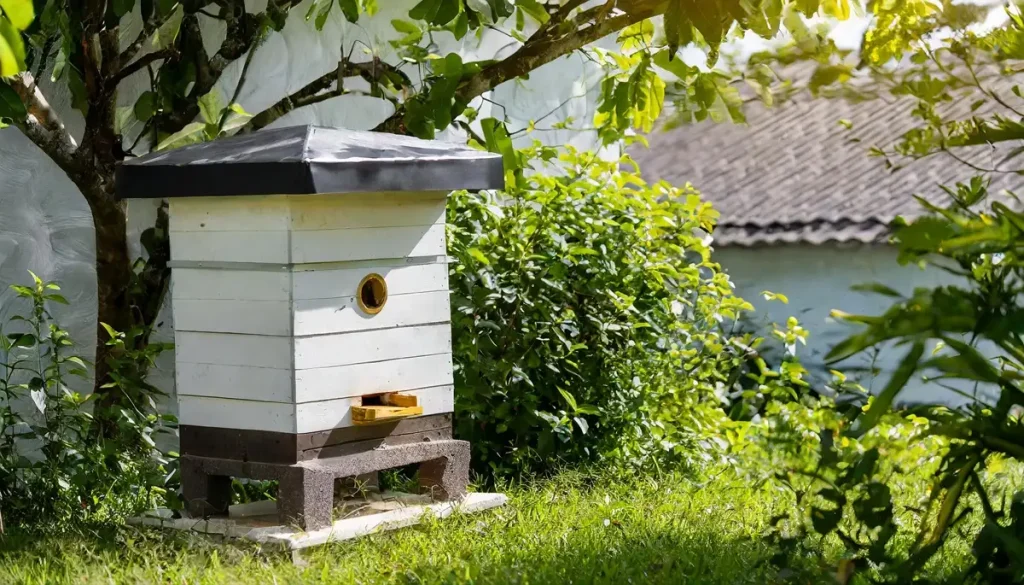Table of Contents
Ideally, a beehive should be placed at least 10 feet away from a house to ensure safety and minimize disturbance to both bees and humans. This distance helps in reducing bee traffic near living areas and lessens the likelihood of human-bee interactions, while still allowing bees to thrive and perform their ecological roles effectively. It’s also important to consider local regulations and neighborhood context when siting a beehive.
In the below paragraphs, we will take a more detailed look at this topic.
Beekeeping is often described as a hobby that is easy to do once you get the hang of it. This is true in principle, but there is a lot to learn along the way. For example, how far from the house should bee hives be placed? The answer to that question is not as black and white as it at first may seem. Indeed, there are a lot of variables that have to be considered.
You ideally want enough space between your hives and your house to allow the bees to fly in any direction without issue. Give them enough space to get the altitude they need without having to fly immediately up and over your house. You will increase the chances that they will spread out in every direction this way.
If you are new to beekeeping, your choice of hive locations will be one of the most important decisions you make. You should probably invest more time in researching where to locate your hives than worrying about the tools you need to buy. A beekeeping suit is pretty straightforward. The proximity of your hives in relation to your home is anything but.
Up, Up, and Away
The starting point for this discussion is understanding bee flight. Note that honeybees are capable of flying for miles in any direction in their search for nectar. And they often do. If your beekeeping operation is located in a suburban area where nectar is in short supply, your bees just might fly a considerable distance as a matter of routine. It is not a problem.
How does this relate to the proximity of hives in relation to your house? It’s pretty simple. It can take the average honeybee up to 6 feet of linear distance to gain 6 feet of altitude. Also note that bees are like any other creature in that they tend to take the path of least resistance. So if hives are so close to your house that it’s hard for the bees to gain altitude, they will be more apt to fly the other direction.

Stay Out of the House
Your next consideration is whether or not you want bees inside your house. Believe it or not, honeybees are lazy creatures. If they can get food within 10 feet of the hive rather than flying a mile for nectar, you can bet they’ll take it. This suggests that placing bees too close to your home will result in them trying to get into your house in search of food.
This is not necessarily an issue because you love bees anyway. But the rest of your family may not agree. Having bees in the house could be problematic for them.
The other side of that coin is locating hives somewhere on your property that makes them too close to your neighbor’s house. Bank on the fact that they do not want your hives nearby. If the bees have to invade someone’s house, it really should be yours.
Nearby Food Sources
Hand-in-hand with bees getting into your house is the prospect of bees using the flowers and plants of your landscaping as a major food source. This is not necessarily a bad thing inasmuch as those flowers and plants need to be pollinated as well. But the combination of excessive landscaping and hives placed too close to the home could create a situation in which the volume of bees buzzing around makes people uncomfortable.

You still want your bees to pollinate your exterior plants and flowers. But you also want them to fly away in search of other food sources. So the further they are from your home, the better off you and they will be.
- Carter, Anthony (Author)
- English (Publication Language)
- 194 Pages - 02/28/2024 (Publication Date) - Independently published (Publisher)
Remember the Children
Next, you always have to consider the presence of children when you are keeping bees. Kids are naturally afraid of bees, especially if no one has taken the time to familiarize them with the insects in a non-threatening way. But that is not really the point here.
Honeybees are generally docile as long as they don’t feel threatened. By the same token, kids do not have a tendency to pay attention to what goes on around them. Bee hives placed too close to your house are an open invitation for trouble. Kids playing outdoors could get too close to the hives without knowing it, causing a reaction among worker bees that suddenly feel threatened by all the commotion.
Even if kids do not get too close to the hives, you have to remember that bees will be buzzing around within six or seven feet of the hive. This could make for inadvertent collisions between them and your kids, which is something else you don’t need.

Hive Maintenance Considerations
We assume you are not keeping bees just because you like the work involved. If you’re like most people, you at least want to harvest the honey bees produce. Harvesting and other hive maintenance considerations work into the equation here.
How do you plan to carry out regular maintenance? Where do you plan to harvest the honey? A lot of hobbyists use an exterior garden shed or garage to handle these things. That being the case, you would logically want your hives closer to the exterior structure than your home. There is no sense in hauling heavy supers across your property just to harvest the honey.
The other thing to consider is that maintenance can agitate your bees. Keeping your hives well away from your house reduces the risks posed to family members and pets should your bees decide they are not happy with your maintenance work.
Use Common Sense
Unfortunately, we cannot provide a hard and fast number like 50 feet. Beekeeping just doesn’t work that way. Most experts recommend that you simply use common sense. Take into consideration all the variables listed in this post and then make your hive location choices accordingly.
Always remember that the ultimate goal of keeping bees is to manage hives that thrive year after year. Where you choose to locate your hives will play a role in your success, so choose wisely.
How Far From the House Should Bee Hives Be – Conclusion
In conclusion, knowing the appropriate distance to place your bee hives from your home is crucial to ensure the safety of your family, pets, and visitors. Additionally, proper hive placement can maximize honey production and enhance the overall health of your colony. By following the guidelines outlined in this article, you’ll be able to choose the perfect location for your bee hives and enjoy the benefits of beekeeping without any worries. Remember to always consult local regulations and seek advice from experienced beekeepers in your area before starting your own colony. Happy beekeeping!
Looking to up your beekeeping game? Check out our latest product recommendations so you can take things to the next level!
Introducing The Top 12 Best Beekeeping Veils For 2024
Introducing The Top 20 Best Beekeeping Gloves For 2024
Introducing The Absolute Best Beekeeping Suits For 2024
The 15 Top Beekeeping Books for 2024
The Top 11 Honey Extractors for 2024
The Top 12 Mason Bee Houses for 2024
Beekeeping Disclaimer:
Beekeeping, like any agricultural activity, involves inherent risks. It is important to understand these risks and take appropriate measures to mitigate them.
Potential risks associated with beekeeping include:
- Bee stings: Honey bees are generally not aggressive but can become defensive if they feel threatened or their hive is disturbed. Bee stings can cause allergic reactions or even anaphylaxis in some individuals, which can be life-threatening. It is important to wear protective clothing and follow best practices when handling bees to minimize the risk of stings.
- Diseases and pests: Bees can be vulnerable to various diseases and pests, including mites, viruses, and bacterial infections. These can have significant impacts on bee colonies, leading to reduced honey production or even colony collapse. It is important to monitor hives regularly and take appropriate measures to prevent and treat diseases and pests.
- Weather conditions: Extreme weather conditions, such as drought or cold temperatures, can affect the health and productivity of bee colonies. It is important to ensure that hives are appropriately sheltered and provided with adequate food and water.
- Environmental hazards: Bees can be affected by environmental hazards such as pesticide exposure, pollution, and habitat loss. It is important to be aware of these hazards and take appropriate measures to protect bee colonies and promote healthy environments for bees.
- Legal requirements: Beekeeping may be subject to local, state, or national regulations, such as registration or inspection requirements. It is important to be aware of these requirements and comply with them.
While beekeeping can be a rewarding and enjoyable activity, it is important to be aware of the potential risks and take appropriate measures to mitigate them. By following best practices and staying informed about the latest developments in beekeeping, beekeepers can help ensure the health and productivity of their hives and contribute to the well-being of bee populations worldwide.
Last update on 2024-04-17 / Affiliate links / Images from Amazon Product Advertising API




